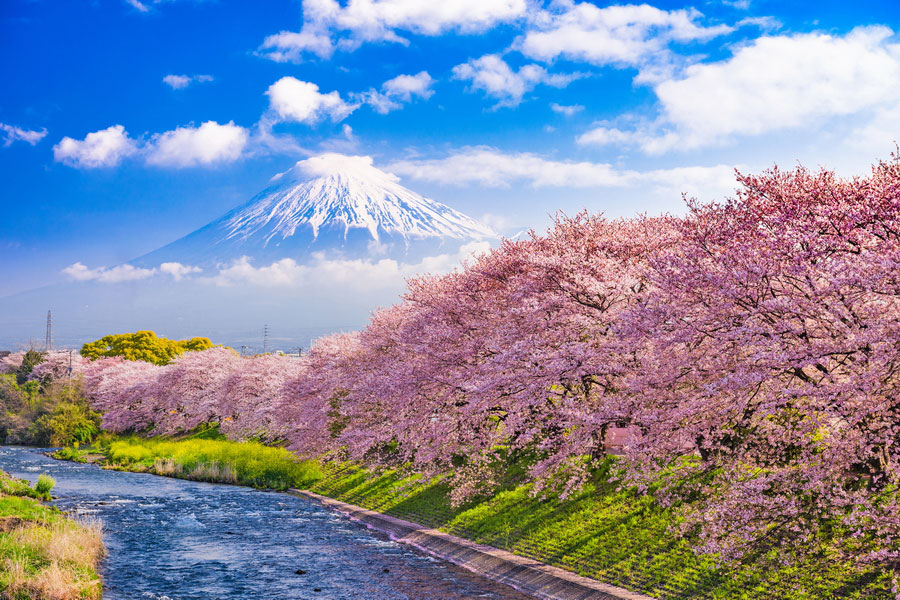Tours, Attractions and Things to Do in Mount Fuji
Mount Fuji Travel Guide
More than just a mountain, Mount Fuji is a cornerstone of Japanese philosophy, religion, literature and art, embodying the cultural identity of an entire nation and serving as its most iconic symbol. Recognised around the world, Mount Fuji consistently tops lists of must-see destinations in Japan, including awards from US News.
At 3,776 meters, Mount Fuji (富士山, Fuji-san or Fujiyama) is Japan's tallest peak, renowned for its symmetrical cone shape. Located on Honshu Island, about 100 kilometers southwest of Tokyo, it straddles the Yamanashi and Shizuoka prefectures and forms part of the Fuji-Hakone-Izu National Park. It has been a UNESCO World Heritage Site since 2013.
Fuji: Definition, Location and Common Information
The origin of the name "Fuji" remains uncertain, but some theories trace it back to the mythology of the Ainu people, who worshipped the goddess of fire, Kamui Fuchi (ムイフチ), or Fuji. Other interpretations associate the name with concepts such as abundance, immortality and incomparability, reflecting the mountain's cultural and spiritual significance.
For travelers eager to explore this iconic natural wonder, our Fuji Travel Guide is your ultimate resource. It provides in-depth information about the cultural and historical significance of Mount Fuji, details on the surrounding infrastructure such as transportation and accommodations, and guides to shopping, dining, and more. This guide is designed to help you make the most of your visit.
Mount Fuji Tours
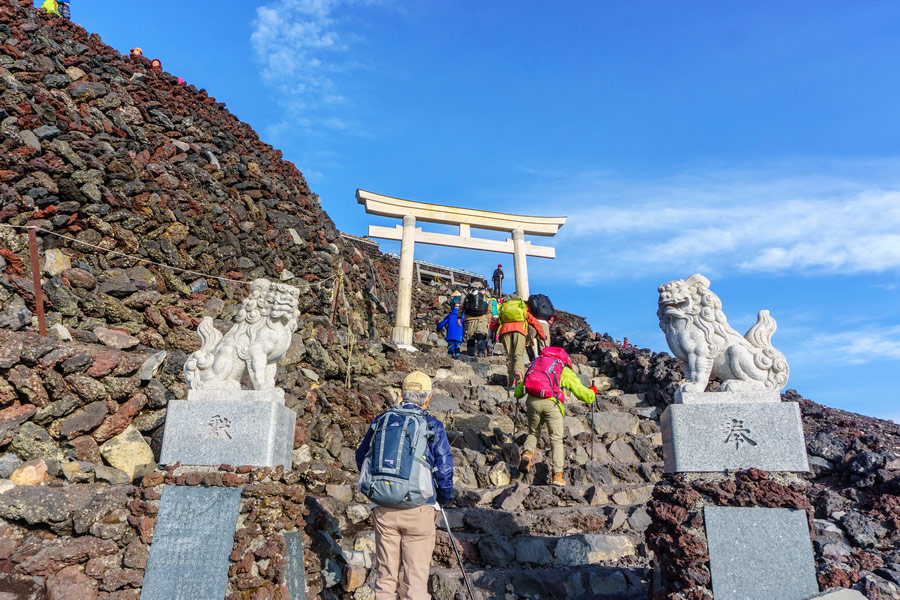
Fuji-Hakone-Izu National Park attracts nearly 95 million visitors annually, with 300,000 climbers ascending Mount Fuji during its climbing season from July to September. This makes Fuji one of the most visited destinations in the world.
Here are the most popular types of tours to Mount Fuji:
Mountain Hiking Tours. Available exclusively from July to September, these tours cater to those wishing to climb the iconic peak.
Pilgrimage Tours. As a sacred site, Mount Fuji draws many visitors from Japan and beyond who seek spiritual experiences.
Cultural Tours. Discover the cultural significance of Fuji through visits to nearby museums, temples, and parks, which offer insight into local traditions.
Health Tours. Relax at the hot springs at Fuji’s base, where you can enjoy breathtaking views while rejuvenating your body.
Nature Tours. Explore the stunning landscapes surrounding Mount Fuji, including the famous Five Lakes, perfect for picnics, fishing, and camping.
While many tourists opt for day trips to Mount Fuji from Tokyo, longer stays in Fuji view hotels provide a chance to fully immerse yourself in the beauty and tranquility of the area.
Best Time to See Mount Fuji
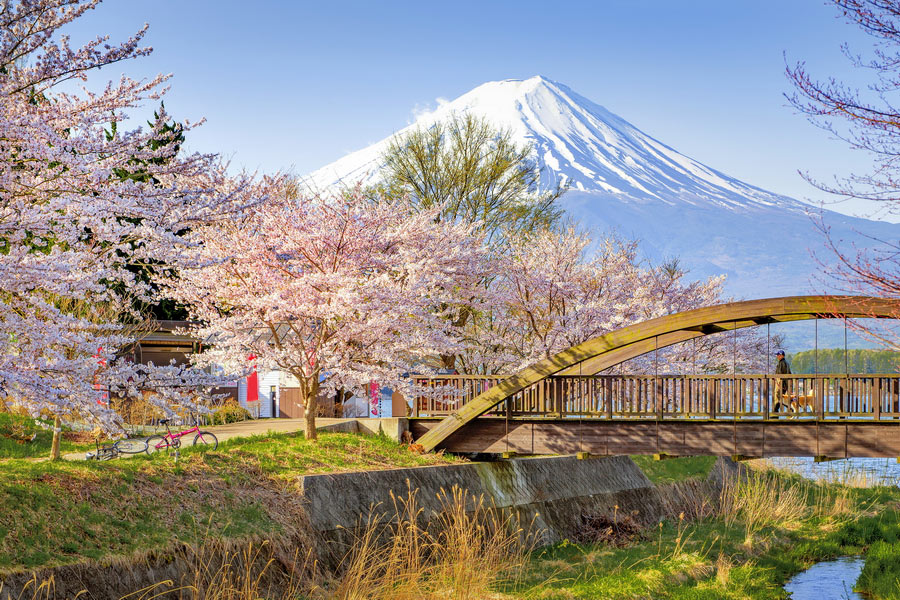
The peak tourist season and the best time to see Mount Fuji is from April to September. In April, the weather is relatively warm, with air temperatures around 15°C. This is also a perfect time to enjoy cherry blossoms and the festival held along the shores of Lake Kawaguchiko.
The best summer months to see Mount Fuji are July and August, when air temperatures can reach up to 30°C. While these months are rainy, they mark the start of the climbing season, which typically runs from early July to the end of August.
Winter is also an excellent time to view Mount Fuji, as the colder months bring clearer skies and significantly better visibility due to reduced rainfall.
History of Mount Fuji
Historical Facts About Mount Fuji
- Mount Fuji was formed from three overlapping volcanoes.
- The first of these volcanoes was formed around 100,000 years ago.
- Since the 8th century, Mount Fuji has erupted approximately 15 times.
- The volcano was most active between 781 and 1083, with nine eruptions during this period, the most powerful occurring in 874.
- The last eruption of Mount Fuji took place in 1707 and lasted for over two weeks.
- The most recent volcanic activity observed at Mount Fuji occurred in the 1960s.
- The first recorded ascent of Mount Fuji dates back to the year 663.
- Walter Weston (1861–1940), an English preacher, is regarded as the father of modern mountaineering in Japan. He climbed Mount Fuji in 1892.
- Women were prohibited from climbing Mount Fuji until nearly the end of the 19th century.
Landmarks and Attractions
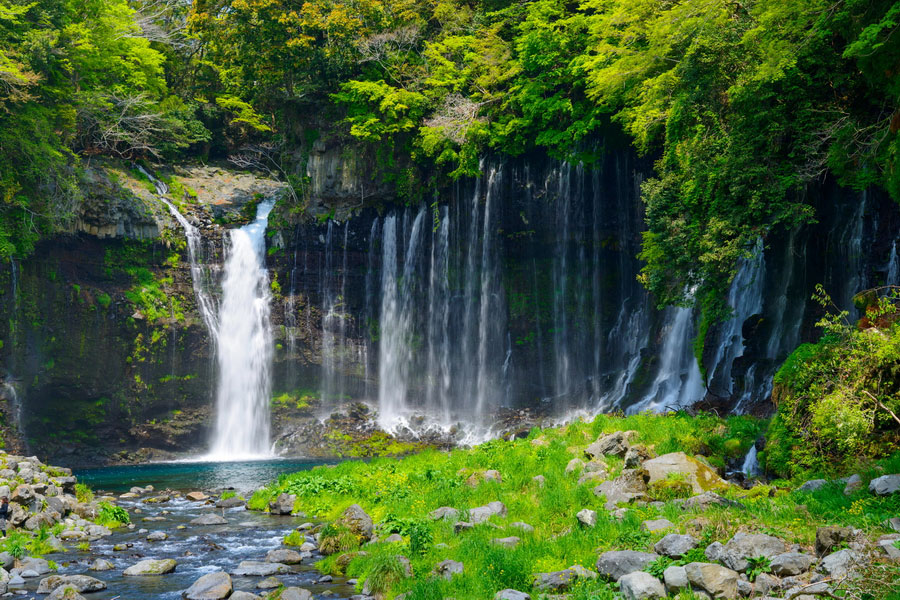
Must-See Attractions Around Mount Fuji
The area surrounding Mount Fuji is home to numerous attractions, including temples, shrines, museums, parks, lakes, and waterfalls. Here are some of the most interesting and popular places to visit around Mount Fuji:
Fujisan Sengen Taisha Shrine (富士山本宮浅間大社)
This is the region’s main and most visited Shinto shrine. Located at the foot of Mount Fuji in the town of Fujinomiya, it was founded in the 9th century to protect against volcanic eruptions. The shrine expanded over time, with the last structure added by Tokugawa Ieyasu (徳川 家康) in the 17th century.
Arakura Sengen Shrine (新倉富士浅間神社)
Known for the Chureito Pagoda (忠霊塔), this shrine is iconic in many photographs and drawings of Mount Fuji, where the pagoda traditionally rises alongside the mountain.
Saiko Iyashi-no-Sato Nenba (いやしの里)
An open-air museum situated near the Eight Springs of Oshino Hakkai (忍野八海), located between Lake Kawaguchi and Lake Yamanaka. It’s a pilgrimage site for many Japanese who believe in the mystical power of the spring water that flows from Mount Fuji.
Mt Fuji World Heritage Centre
Opened in 2017, this museum is dedicated to the history and significance of Mount Fuji. Its building design, shaped like an inverted cone, symbolizes the reflection of Fuji in the surrounding lakes.
Fujikyu Highland (富士急ハイランド)
A well-known amusement park featuring many thrilling, modern rides.
Itchiku Kubota Art Museum
Located on the shores of Lake Kawaguchiko, this museum showcases the decorative techniques of kimonos. Its collection highlights the works of Itchiku Kubota (久保田 一竹) (1917–2003), a master of the art.
Shiraito Falls (白糸の滝)
Considered among Japan’s most beautiful waterfalls, they may only be 3 meters tall, but they span an impressive 70 meters in width.
Five Lakes Area
At the base of Mount Fuji are five famous lakes formed by repeated volcanic eruptions:
- Kawaguchi-ko (河口湖): The most popular lake, known for its easy accessibility, numerous accommodations, and the Kawaguchiko Herb Festival held in June and July.
- Yamanaka-ko (山中湖): The largest of the five lakes.
- Sai-ko (西湖): Known for its tranquility and calm atmosphere.
- Shoji-ko (精進湖): The smallest of the five lakes.
- Motosu-ko (本栖湖): The deepest lake, which never freezes.
Best Things to Do near Fuji
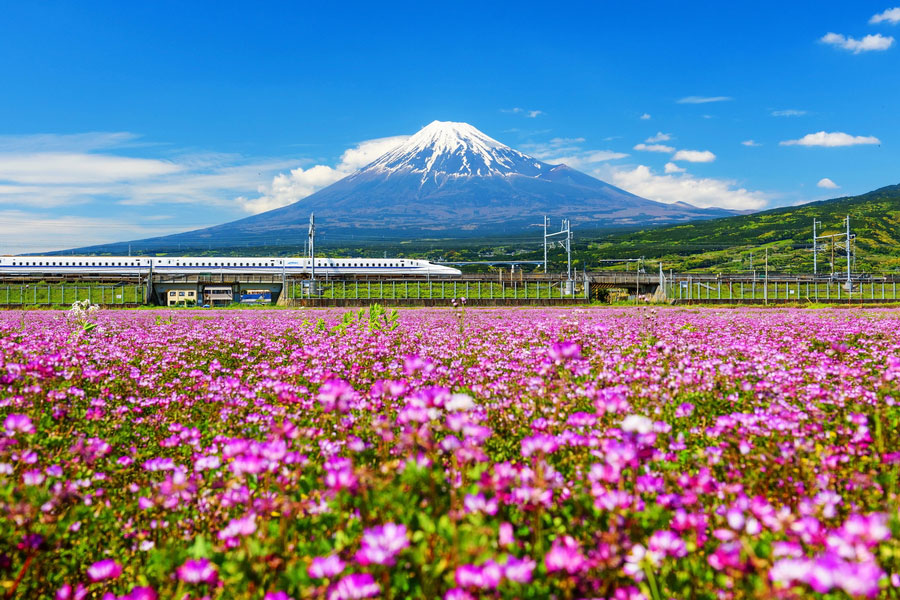
Activities and Experiences Around Mount Fuji
Climbing Mount Fuji
Climbing Mount Fuji is the most iconic activity associated with the mountain, available during the climbing season in July and August. The season ends with the vibrant Yoshida Fire Festival, held at the end of August.
Main Hiking Trails to Mount Fuji:
- Yoshida Trail (吉田): The most popular route, starting from the north at an elevation of 2,300 meters.
- Fujinomiya Trail (富士宮市): The southern trail.
- Subashiri Trail (須走): Located in the northeast.
- Gotemba Trail (御殿場): The southeastern trail.
If you're wondering, "Can you climb Mount Fuji?", the answer is yes! Climbing doesn’t require special preparation, and with good health, you can summit the mountain. From the top, you'll be rewarded with breathtaking views of the surrounding towns, lakes, and even parts of Tokyo on clear days.
Climbing Tips:
- Take your time: Plan a two-day climb, reaching the seventh or eighth level on the first day and staying overnight in one of the tourist huts. Start early the next morning to witness the unforgettable sunrise from the summit.
- Ensure you're healthy: Consult a doctor beforehand, as conditions like high blood pressure could be a contraindication.
- Dress appropriately: Wear layered clothing to adjust to the varying temperatures between the base and the summit. Use comfortable, non-slip footwear.
Enjoying Views of Mount Fuji
If climbing isn’t for you, enjoy the views of Mount Fuji from afar and capture unique photos. Here are the top five places to see Mount Fuji:
- Arakurayama Sengen Park (新倉山浅間公園): Known for the iconic pagoda backdrop in many Fuji photographs, this is a must-visit.
- The Five Lakes Region: Any of the five lakes around Mount Fuji offer stunning views.
- Shinkansen Line (新幹線): Traveling from Tokyo to Osaka, Mount Fuji appears on the right side about 40–45 minutes into the journey on clear days.
- Mount Tenjo Cable Car (河口湖天上山ロープウェイ): Located near Lake Kawaguchiko, this ride offers a panoramic view of Fuji from the mountain's summit.
- Tokyo Observation Decks: High-rise buildings like Mori Tower, Tokyo Tower, and Tokyo Skytree provide distant yet spectacular views of Fuji on clear days.
Relaxing at an Onsen
Experience the rejuvenating hot springs near Mount Fuji, perfect for relaxation and recovery. Some of the most popular onsens include:
- Yamanakako Benifuji-no-Yu Onsen (やまなかこおんせん べにふじのゆ)
- Yamanakako Hirano Onsen Ishiwari-no-Yu (山中湖平野温泉石割の湯)
- Onsen Fujiyama (ふじやま温泉): Conveniently located next to FujiQ Park.
Mount Fuji in Literature and Art
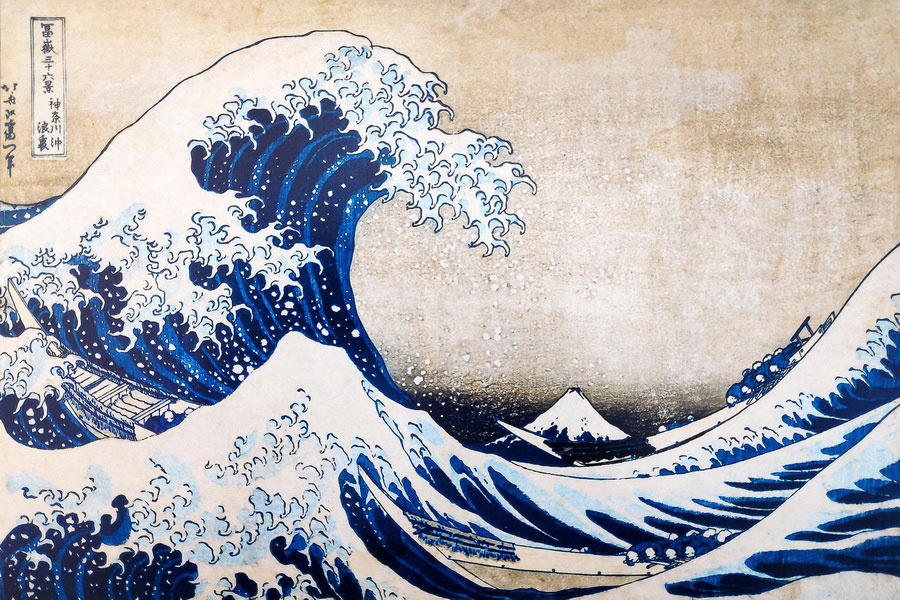
Artistic Depictions of Mount Fuji
The 36 Views of Mount Fuji by Katsushika Hokusai (葛飾 北斎) are the most internationally renowned artworks of Mount Fuji. Created in 1830, this iconic series of woodblock prints includes masterpieces such as "The Great Wave off Kanagawa" and "Red Fuji", which are now celebrated among the most famous works of art worldwide.
In addition to Hokusai's series, Mount Fuji appears in other notable Japanese artworks:
- Pictorial Biography of Prince Shotoku (聖徳太子絵伝) from the Heian period (平安時代): This work, composed of four silk panels, depicts Prince Shotoku riding Mount Fuji on horseback.
- Fuji (富士山) by Kobayashi Kokei (小林古径, 1883–1957).
- Aka-Fuji (あかふじ) by Yokoyama Misao (横山操, 1920–1973).
- Mt. Fuji Dyed Ultramarine (群青富士) (1918) and Mt. Fuji (富士山) (1940) by Yokoyama Taikan (横山大観, 1868–1958): These pieces offer a modern interpretation of the iconic mountain.
Mount Fuji in Japanese Literature
Mount Fuji plays a central role in Japanese literature, appearing in both ancient and classical works:
- Manyoshu (万葉集): One of Japan's oldest collections of poetry, compiled in the 8th century, containing over 4,000 short poems, many of which reference Mount Fuji.
- The Tale of the Bamboo Cutter (竹取物語): A renowned 9th–10th-century tale, recognized as the first work written in the Japanese Monogatari form.
- The Tale of Genji (源氏物語): An 11th-century novel attributed to Murasaki Shikibu, one of the most celebrated works in classical Japanese literature. A Japanese film adaptation of the same name was released in 2011.
- Poetry by Matsuo Basho (松尾 芭蕉, 1644–1694): The 17th-century haiku master frequently featured Mount Fuji in his poems, highlighting its cultural and spiritual significance.
Quotes about Mt Fuji
- He who doesn't climb once is a fool, he who climbs twice is a fool.
(An old Japanese proverb. Citation from Byron Earhart. Mount Fuji, preface); - The cloud’s base Mount Fuji shaped as a cedar grows thicker.
(Haiku by Matsuo Basho (1644-1694)); - Mount Fuji a flea on the cover of the tea grinder.
(Haiku by Matsuo Basho); - A Fuji wind placed here on a fan, a souvenir of Tokyo.
(Haiku by Matsuo Basho); - On a hot summer day, try and recall the view of Mount Fuji.
(Haiku by Shiki Masaoka (1867-1902)); - Japanese love of nature, I often think, owes much to the presence of Mount Fuji. (D.T. Suzuki, 1870-1966).
Food. What to Eat Near Mount Fuji
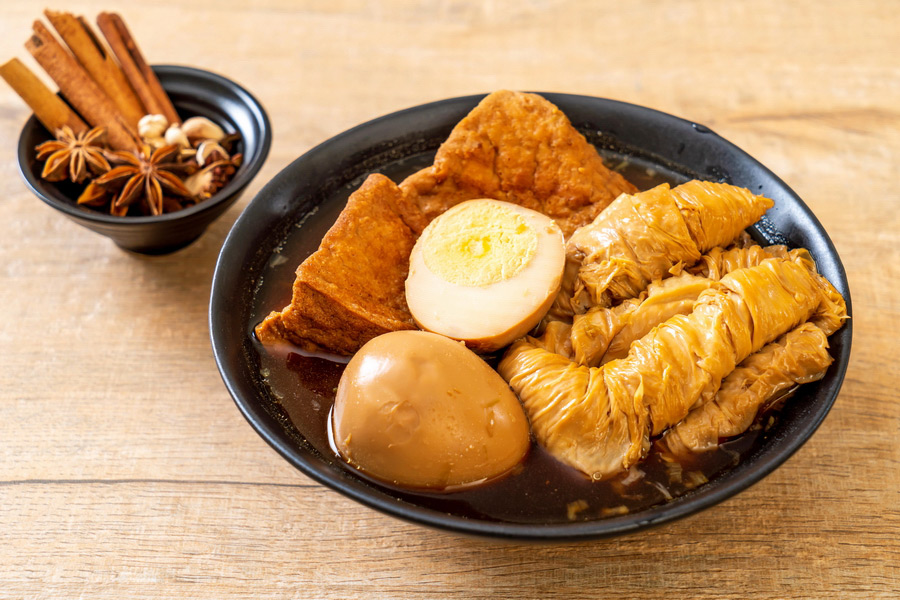
Mount Fuji sits at the intersection of Shizuoka and Yamanashi prefectures, and the regional cuisine reflects the unique culinary traditions of these areas.
Recommended Tastes:
- Hanpen (半片): A surimi fish paste dough, typically made from mackerel in Shizuoka.
- Dark Oden (おでん): A hearty traditional Japanese dish, Shizuoka-style oden features beef tendons, which give the broth its distinctive dark color.
- Sakura-ebi Dried Shrimp (桜えび): Small pink shrimp named after their sakura-like hue, offering a unique flavor.
- Tatami Iwashi (タタミイワシ): A crunchy snack made from dried sardine fry, perfect for light eating.
- Hoto (ほうとう): A hearty soup from Yamanashi, made with thick udon noodles, a vegetable base, and miso.
- Otsukedango (おつけだんご): A miso-based broth filled with fresh vegetables and gnocchi-like dough pieces.
- Fuji-mabushi (富士眩しい): A flavorful dish featuring seabream or trout from Lake Sai-ko, served with rice and spices.
These regional specialties offer a delicious way to experience the flavors of the Mount Fuji region, blending culinary traditions from both prefectures.
Best Places to Go Shopping Around Mount Fuji
When traveling to Mount Fuji, you'll find numerous small shops and souvenir stores offering affordable gifts featuring the iconic peak. Many of these are located at Station 5, the starting point of the Yoshida Trail, where you’ll also find grocery shops. Additionally, small huts and shops on the mountain sell food and drinks, though prices tend to be higher due to the altitude.
For larger shopping options, the area around Fuji also features bigger centers. For example, Gotemba is well-known for its popular outlet centers, offering a variety of goods and discounts.
How to Get to Mount Fuji
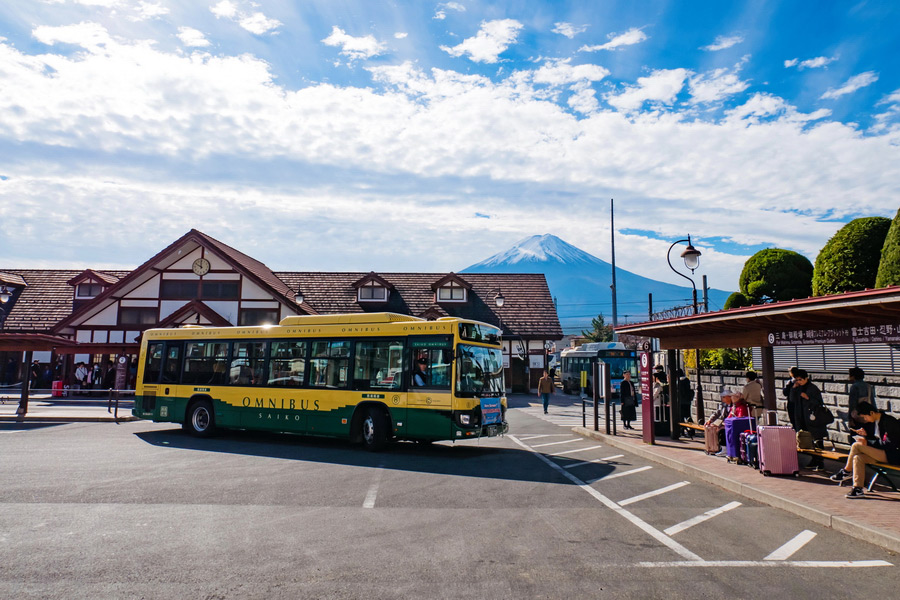
How to Get from Tokyo to Mount Fuji
There are several convenient ways to travel from Tokyo to Mount Fuji, including buses, trains, and a combination of both.
By Bus
One of the fastest and most convenient options is taking a bus:
>JR Kanto and Fujikyu Buses
These buses run frequently, once or twice an hour, departing from Tokyo Station and traveling to Kawaguchiko Station (河口湖駅). The journey takes about two hours and costs approximately ¥1,800.
>Fuji Express Bus
This popular option departs from Shinjuku Station (新宿) and travels to Mt Fuji 5th Station. The journey also takes about two hours, with ticket prices ranging from ¥1,500 to ¥3,500 (~$10–22 USD), depending on the season.
By Bullet Train
The Shinkansen (bullet train) is another excellent choice.
From Tokyo to Shin-Fuji Station (新富士駅):
The bullet train from Tokyo to Osaka passes through Shin-Fuji Station, making it convenient for travelers heading to Mt Fuji. Regular buses connect Shin-Fuji Station to Mt Fuji Station (富士山駅). The total travel time is approximately 2.5 to 3 hours.
From Osaka to Shin-Fuji Station:
For travelers from Osaka, the same train can be taken to Shin-Fuji Station, with a bus transfer to Mt Fuji.
Fuji Excursion Train
For JR Pass holders, the Fuji Excursion Train is an excellent option. It runs from Shinjuku Station (新宿) to Kawaguchiko Station (口湖駅) and passes significant attractions in the region. Most of the journey (Tokyo to Otsuki) is covered by the JR Pass, requiring no extra charge. The train takes about two hours to reach Mt Fuji Station (富士山駅).
Travel from Kyoto
From Kyoto, the bullet train offers a comfortable journey to Shin-Fuji Station, where you can switch to a bus heading to Mt Fuji Station. The total travel time from Kyoto to Mt Fuji is approximately 3.5 to 4 hours.
Local Transport Around Mt Fuji
From Mt Fuji Station (富士山駅):
Intercity transport usually arrives here, located at the foot of the mountain. From this station, the Fuji Tozan Bus (とざん) provides direct access to Mt Fuji 5th Station, located at an elevation of 2,300 meters.
From Neighboring Towns
Mount Fuji is also easily accessible from nearby smaller towns, with well-connected transport options.
These various routes ensure flexible and comfortable travel options for anyone planning to visit Mount Fuji.
Main Cities Near Mount Fuji
Fujinomiya City (富士宮市):
Located between Mount Fuji and Fuji City, Fujinomiya is the closest city to Mount Fuji, just 18 kilometers away.
Fuji City (富士市):
The third most populous city in Shizuoka Prefecture, Fuji City is about 20 kilometers south of Mount Fuji.
Kawaguchiko Town (河口湖町):
Situated on the northern side at the foot of Mount Fuji, Kawaguchiko is a small town and a popular destination for visitors, with many buses arriving here from Tokyo.
Yamanakako (山中湖村):
A small village northeast of Mount Fuji, Yamanakako is located by the lake of the same name.
Gotemba (御殿場市):
Located about 20 kilometers southeast of Mount Fuji, Gotemba is another nearby city and a gateway for exploring the region.
Is Mount Fuji Safe?
Many tourists visiting Mount Fuji are concerned about its volcanic activity, as the iconic mountain is classified as a dormant but still active volcano.
Currently, the likelihood of an eruption is extremely low—over 300 years have passed since the last eruption, and more than 60 years since the last recorded volcanic activity. The Japanese government closely monitors Mount Fuji's condition, ensuring that tourists would be evacuated well in advance if any signs of an eruption were detected. As a result, visiting or climbing Mount Fuji can be considered a safe and enjoyable experience for travelers.


